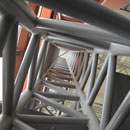Architecturally Exposed Structural Steel
The AESS Categories - AESS Custom
AESS C – Custom Elements was created to allow for a custom selection of any of the Characteristics or attributes that were used to define the other Categories. It will allow flexibility in the design of the steel, but will therefore require a high level of communication amongst the Architect, Engineer and Fabricator. The premium for this type of AESS could range from 20% to 250% over regular steel. A wide range may seem odd for "custom" elements, but the lower bound of this Category also includes specialty reused steel for sustainable purposes, and steel that might be purposefully less refined in its Characteristics.
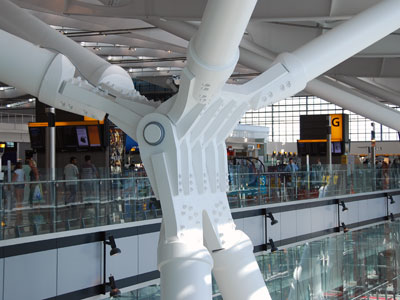 |
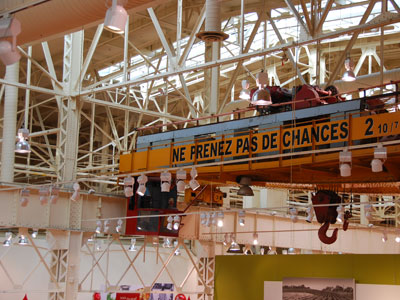 |
Heathrow Terminal 5 in London, England by Sir Richard Rogers Architect uses a range of AESS Category types throughout the terminal. These specialty connections use a combination of custom work for the central "hinge", castings to connect the ends fo the large HSS supports and truss members to the hinge, and showcase level of fabrication and finish for the legs/column supports. You need to be flying British Airways to come across this steel! |
Angus Technopole, Montreal is a unique application of the reuse of a former locomotive shop as offices and commercial space. They have chosen to leave the riveted steel "as is", with minimal cleaning and no repainting to preserve the original look and feel of the building. Where new steel is required in this project a custom specification is required in order to make it fit into the aesthetics of the old building. |
The Custom Elements checklist in the Matrix will also allow design teams, that may have become familiar with the new AESS Specification Suite to create their own checklist for a project, that better reflects the nature of the aesthetics or function of the project. The Custom checklist also allows for the addition of "extra" criteria of fabrication that must be agreed upon amongst the team and that will be used to achieve particular or unusual finishes. This category will be suitable where specialty castings are used as these require different handling and finishing than do standard steel sections due to their inherently different surface finish as a direct result of the casting process.
With increases in the reuse of steel for sustainably minded projects, a unique set of criteria will come into play. Requirements will center around the presence of existing finishes, corrosion, inconsistencies between members, and whether the project desires to showcase the reuse or blend the material with new material. As some historic steel is fastened with rivets, different treatment may be required where new connections are mixed with old in order to create visual coherence.
The Custom Category will also provide the ability to create a checklist for members that may be more sculptural in nature. In some instances the nature of the steel is intended to be a highlight of the finished project, and in other cases, the nature of the steel is to be concealed and the final product to look more "plastic" in nature. The former may require "less care" and the latter a higher degree of finish and workmanship than would be required even for structures in the AESS 4 range.
The use of stainless structural steel will also be addressed in this category as this material has different specifications and particular issues that must be included to ensure a high quality of installation.
AESS Custom - Characteristics
AESS C – Custom Elements was created to allow for a completely custom selection of any of the Characteristics or attributes that were used to define the other Categories. It allows complete flexibility in the design of the steel, but therefore requirse a high level of communication amongst the Architect, Engineer and Fabricator. The premium for this type of AESS could range from 20% to 250% over standard steel. A wide range may seem odd for "custom" elements, but the lower bound of this Category also includes specialty reused steel for sustainable purposes, and steel that might be purposefully less refined in its Characteristics.
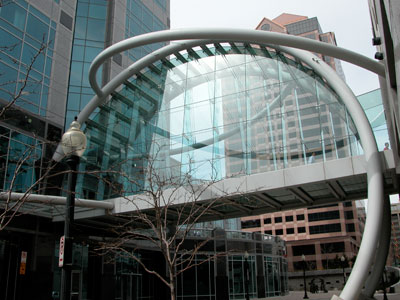 |
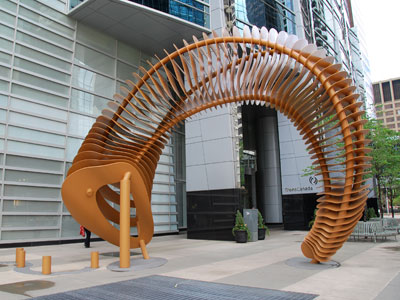 |
Wells Fargo Pedestrian Bridge, Salt Lake City, Utah. Seamless curved structures have their own fabrication and erection concerns. Bending steel is a very particular process that has its own technical requirements to ensure that the surfaces do not warp or buckle. |
The Ram's Horn in Calgary, Alberta. In this project the artist very much wanted the rough nature of the steel to show through, so many aspects that would normally be removed in an AESS project were purposefully retained to enhance the understanding of the materiality of steel. |
It is strongly recommended that the Team sit down with the Matrix and Specification documents in hand and manually go through the list of Characteristics. As is illustrated by the range of projects pictured, the complexity, size, level of finish and types of members used can greatly vary in Custom projects - leading to a wide variation in the cost premium to be expected for this type of project.
The unusual areas of concern for AESS Custom projects might include:
• oversized members
• extraordinary geometries
• curved members
• accessibility issues
• unusual finish requirements
• high levels of grinding and filling for connections
• transportation problems associated with member size
• difficult handling or extra care needed to protect pre-painted components
